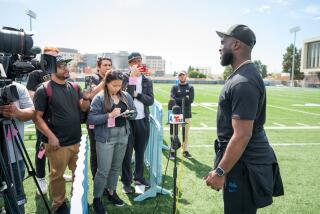Blue Meets Blue
The best place to have lunch in Los Angeles doesn’t have valet parking, Asian-fusion spring rolls or Argentinian wine. Or even a roof. Celeb sightings are rare, but it does have post-card views of the San Gabriel Mountains and the Hollywood sign. The service is pretty scarce but the food is good--that is, if you bring good food.
Welcome to the top deck of Dodger Stadium, the uppermost shelf of pale blue seats some nine stories above the Bermuda grass. In what must be one of the great missed opportunities in fan gouging, the several thousand seats in the top deck are free and open to the public every day the ballpark is open. Just so long as there isn’t a game.
I suppose I’m a bit of a connoisseur of empty stadiums. As I add it up, I’ve been to quite a few--the Colosseum in Rome, Kenan Stadium at the University of North Carolina-Chapel Hill, the geographically scaled Daytona and Indianapolis speedways. You don’t have to be T.S. Eliot to appreciate the poetry of unoccupied grandstands--empty seats being inexpressibly entangled in the lives of the multitudes who have filled them.
The presence of absence is heavy at Dodger Stadium, which is the best-attended venue in baseball. About 120 million people have toggled the turnstiles since Dodger owner Walter O’Malley opened the gates in 1962. And not just for baseball. Pope John Paul II celebrated Mass here in 1987. The Beatles consecrated the field in 1966.
A friend told me about the top deck a few months ago, and since then I’ve been here three times--this time well equipped, with a sandwich, bottled water and binoculars. There’s plenty of action even in an empty stadium. Suburban dads and other specialists in turf management can while away an hour admiring the efforts of the groundskeepers. As I unwrap my sandwich, one of these blue-shirted worker ants is stretching a surveyor’s line down the baseline. He’ll spend the better part of the afternoon with a motorized edger, walking behind it heel-to-toe as if taking a sobriety test, putting a razor’s edge onto the agro-engineered grass. This kind of care you can’t buy with working wages alone.
Other petty dramas unfold at a distance. A maintenance man coaxes a broken seat back into place. A tour guide tries to round up some kids who’ve infiltrated the box seats. Dodger Stadium is one of those places that remind us that life goes on, even if we’re not there.
Dodger tickets are, of course, available online and by phone, and perhaps that’s the reason that the people who show up in person to purchase their tickets from the stadium ticket office are mostly working class and Latino, people who generally have more faith in cash transactions. There’s a pattern to their discovery. They’ll buy their tickets, then notice that the gates are open. They look around--is it a mistake? Am I trespassing? Then, cautiously, they’ll walk through the gates and to the edge of the cascading seats, where the whole of the stadium opens up in a mighty vectoring expanse at their feet. The sight of grass, crosshatched like green gabardine, seems to make them falter, and they take a seat, never quite taking their eyes off the view.
The acoustics of stadiums are such that they shelter those inside from the noise outside. Rome is the noisiest city in Western Europe, but the sounds of the city cannot get past the Colosseum’s travertine ramparts, so the sound you hear there is what the Romans heard, the sound of antiquity.
Dodger Stadium may be the quietest outdoor space in the raucous metropolis, and the effect is stunning. “There’s something about being in the baseball park when there’s nobody here,” says Ed Greenman, visiting with his 12-year-old son, Gabriel. “It’s very tranquil.”
In the quiet of the stadium, the memories come back thick and vivid. People sit and wait for them to alight.
“What I think about always is the first time I was here,” says Joel Gitterman, in the stands with his sister Marna. “Koufax was pitching. I was 8 years old and I’d never seen a game before.” Dodger Stadium, Gitterman says, “just gives you the atmosphere of a famous place.”
We’ve done well to keep Dodger Stadium. It’s now the fourth-oldest venue in the majors, yet its Atomic architecture--the saw-toothed cantilevered awnings and polygonic scoreboard, the drafting of Emil Praeger--looks comparatively more modern than stadiums built in the ‘80s and ‘90s, whose architecture seems as dated as boxy blazers and fade haircuts.
We’re fortunate too that Dodger Stadium, with its $6 summertime tickets, hasn’t become a shrine to the advantaged, like the platinum-plated Staples Center. Born in shame--the construction in Chavez Ravine displaced a community of Latino families--Dodger Stadium has redeemed itself as the living room of L.A.’s larger family.
And it’s open for lunch.
More to Read
Go beyond the scoreboard
Get the latest on L.A.'s teams in the daily Sports Report newsletter.
You may occasionally receive promotional content from the Los Angeles Times.










